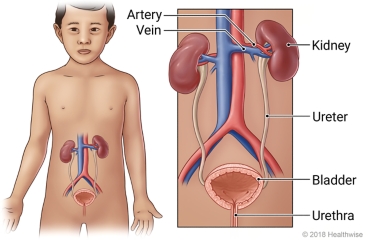
What is it?
A urine culture is a test to find germs (such as bacteria) that can cause an infection. A sample of urine is added to a substance that promotes the growth of germs. If no germs grow, the culture is negative. If germs that can cause infection grow, the culture is positive. The type of germ may be identified using a microscope or chemical tests.
Why is this test done?
A urine culture may be done to find out if symptoms like pain or burning when urinating are from a urinary tract infection (UTI). The test can also find the cause of a UTI, help determine the best treatment for a UTI, and find out whether the treatment has worked.
How do you prepare for the test?
- Your child will need to drink enough fluids and try to avoid urinating so that you will be able to collect a urine sample. Your child may need your help drinking enough and not going to the bathroom before the test.
- The first urine of the day is best because bacterial levels will be higher.
How is the test done?
You will be asked to help collect a clean-catch midstream urine sample from your child for testing.
- Wash your hands before you collect the urine. (If your child will be helping, have your child wash his or her hands too.)
- If the container has a lid, remove the lid. Set it down with the inner surface up.
- Clean the area around your child's penis or vagina. If you use baby wipes, use each wipe only one time.
- Have your child start to urinate into the toilet or urinal.
- After the urine has flowed for several seconds, place the collection container in the stream (or ask your child to carefully hold it). Collect about 2 ounces (a quarter cup) of this "midstream" urine without stopping the flow.
- Don't let the rim of the container touch your child's genital area.
- Your child can finish urinating into the toilet or urinal.
- Carefully replace the lid on the container.
- Wash your hands. (Your child should wash his or her hands too.)
- Return the container to the doctor or nurse, or place it where you were told.
If your child is still in diapers, you will get a special bag that fits inside of the diaper to collect the sample. The doctor or nurse will show you how to use it.
What happens after the test?
- Your child will probably be able to go home right away.
- Your child can go back to his or her usual activities right away.
Follow-up care is a key part of your child's treatment and safety. Be sure to make and go to all appointments, and call your doctor if your child is having problems. Ask your doctor when you can expect to have your child's test results.
Where can you learn more?
Go to http://www.healthwise.net/patientEd
Enter T230 in the search box to learn more about "Urine Culture: About Your Child's Test".
Current as of: September 25, 2025
Author: Ignite Healthwise, LLC Staff
Clinical Review Board
All Ignite Healthwise, LLC education is reviewed by a team that includes physicians, nurses, advanced practitioners, registered dieticians, and other healthcare professionals.

